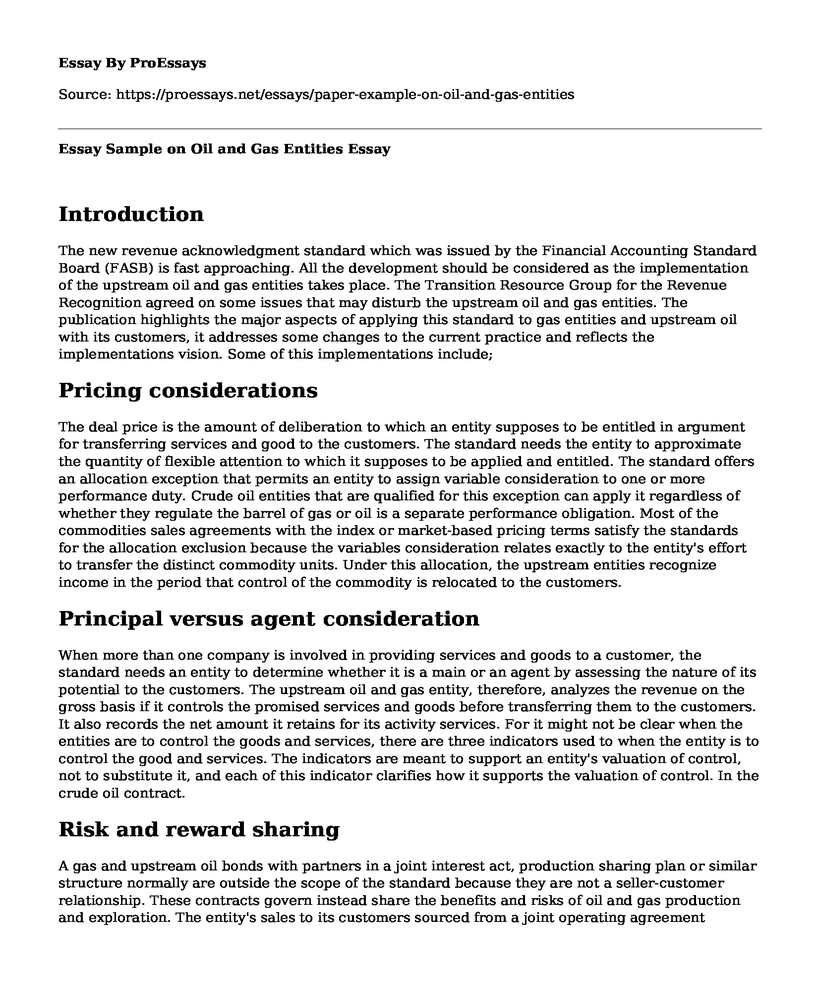Introduction
The new revenue acknowledgment standard which was issued by the Financial Accounting Standard Board (FASB) is fast approaching. All the development should be considered as the implementation of the upstream oil and gas entities takes place. The Transition Resource Group for the Revenue Recognition agreed on some issues that may disturb the upstream oil and gas entities. The publication highlights the major aspects of applying this standard to gas entities and upstream oil with its customers, it addresses some changes to the current practice and reflects the implementations vision. Some of this implementations include;
Pricing considerations
The deal price is the amount of deliberation to which an entity supposes to be entitled in argument for transferring services and good to the customers. The standard needs the entity to approximate the quantity of flexible attention to which it supposes to be applied and entitled. The standard offers an allocation exception that permits an entity to assign variable consideration to one or more performance duty. Crude oil entities that are qualified for this exception can apply it regardless of whether they regulate the barrel of gas or oil is a separate performance obligation. Most of the commodities sales agreements with the index or market-based pricing terms satisfy the standards for the allocation exclusion because the variables consideration relates exactly to the entity's effort to transfer the distinct commodity units. Under this allocation, the upstream entities recognize income in the period that control of the commodity is relocated to the customers.
Principal versus agent consideration
When more than one company is involved in providing services and goods to a customer, the standard needs an entity to determine whether it is a main or an agent by assessing the nature of its potential to the customers. The upstream oil and gas entity, therefore, analyzes the revenue on the gross basis if it controls the promised services and goods before transferring them to the customers. It also records the net amount it retains for its activity services. For it might not be clear when the entities are to control the goods and services, there are three indicators used to when the entity is to control the good and services. The indicators are meant to support an entity's valuation of control, not to substitute it, and each of this indicator clarifies how it supports the valuation of control. In the crude oil contract.
Risk and reward sharing
A gas and upstream oil bonds with partners in a joint interest act, production sharing plan or similar structure normally are outside the scope of the standard because they are not a seller-customer relationship. These contracts govern instead share the benefits and risks of oil and gas production and exploration. The entity's sales to its customers sourced from a joint operating agreement normally are in the choice of the revenue standard, irrespective of the type of ownership concern the entity holds because the supplies are outputs of the entity's normal activities and are sold to their customers. Mineral growth agreements in some countries may be ruled by production distribution contract (PSC). While every PSC is exclusive the two primary models are concession contractual and agreement system. In both types of models, the upstream entity naturally bears the full risk of examination and development. In some cases, the government may contribute through a state-owned gas and oil company.
Cite this page
Essay Sample on Oil and Gas Entities. (2022, Oct 14). Retrieved from https://proessays.net/essays/paper-example-on-oil-and-gas-entities
If you are the original author of this essay and no longer wish to have it published on the ProEssays website, please click below to request its removal:
- History of a Currently Known Technology - Report Example
- Sustainable Design of Skyscrapers
- Key Drivers of Oil Price Changes in the Past Paper Example
- The Effect of World Oil and Gas Crises on the Economic Condition of Oman Paper Example
- Essay Example on the Debate Over Nuclear Power: Natural Gas vs. Nuclear
- Essay on C-5 Galaxy: Comparing B-2 Stealth Bomber with Lockheed Martin's Lifters
- Essay on Petroleum Economics: Examining Factors to Make Investment Decisions







